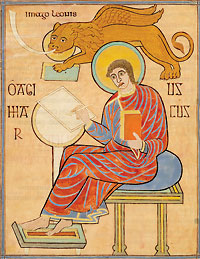The British Library
Giving the Past a New Future

A curator compares the original manuscript of Alice’s
Adventures Undergroud , given by Lewis Carroll to Alice Liddell
in 1864, with the British Library’s
“Turning the Pages” digital facsimile.
You could be forgiven for assuming the British Library
is a truly ancient institution, populated by dusty academics and bearded
revolu tionaries poring over Victorian tracts For an organization so dedicated
to knowledge, the Library has been con stantly dogged by profound ignorance
Steve Hare demolishes a few myths.
Every civilized country boasts a national library.
It is an essential part of any definition of “civilization.” What
often starts with the gifts of generous patrons and avid collectors is usually
formalized at some point by the notion of legal deposit: a law dictating
that a copy of every item published in the country is to be given to the
national library. A collection of treasures thus becomes a point of access
for the country’s collective genius and a major research facility.
The Library of Congress, in Washington, D.C., dates back two centuries and
its Thomas Jefferson Building to 1897. If that library is the world’s
biggest, the British Library is not far behind, managing 400 miles of shelving
against the Library of Congress’s 530. But it might just pip them
for the sheer size of its collection, with an estimated 150 million items
against the American national library’s 130 million. That’s
no surprise, surely, since the British Library must have been around forever?
In fact, far from being an ancient institution,
the British Library only came into being in 1973 and didn’t have its
own building until 1997. Prior to that, it was primarily a department of
the British Museum, from that institution’s foundation in 1753. Today,
the Round Reading Room, where Karl Marx researched Das Kapital, is
primarily a tourist magnet within the Museum’s Great Court, half a
mile south of the new Library, and now light years away in approach, attitude,
and facilities. The old Museum Library—the first public library in
Britain—struggled desperately in its later years to house and conserve
its rapidly growing stock. Much of the collection was dotted around London,
often in damp basements, and ordering an obscure title might entail a wait
of weeks for the hapless researcher. The solution to this increasingly urgent
problem was to establish the Library as a separate entity with its own dedicated
building.
The flagship home for the national collection,
the new British Library complex on Euston Road in the heart of London, broke
ground in 1982 and finally opened in 1997. It’s a minor miracle of
engineering, though most visitors will never be aware of this. The book
stacks and mechanical handling systems are all far below ground and out
of sight. The exterior is a magnificent response to its location and neighbors,
a stark 1960s office block on one side and the magnificent neo-Gothic of
St. Pancras Station and its accompanying hotel on the other. Behind the
library, amongst a forest of cranes, the new Channel Tunnel terminal is
emerging (confusingly enough some seventy miles from the actual tunnel at
Dover).
This whole site was once a huge Victorian goods
yard where the coal that caused London’s smog was delivered to the
capital by steam train. Long derelict, the site was finally picked for the
library, once officials ditched an earlier proposal to flatten several acres
of Georgian architecture on Bloomsbury Square, to the eternal gratitude
of local residents, academics, and conservationists.
Planning for this, the largest public-sector development
in twentieth-century Britain, started in the 1950s and was never rushed.
It became not simply a commission, but virtually an entire career for architect
Colin St. John Wilson and a constant source of frustration and compromise.
With funding released in an unsteady and reluctant trickle, his ideas and
ideals took a battering from succeeding governments—particularly when
the property boom of the 1980s prompted Prime Minister Margaret Thatcher
to argue that a potentially lucrative chunk of real estate was being wasted
on mere books. The site was carved up and future construction phases summarily
cancelled, ending forever the library’s hope of housing the entire
collection on a single site. The delays and endless changes drove the project
cost from £36 million (about $90 million in the late 1960s) to £500
million ($820 million) by its completion three decades later.




